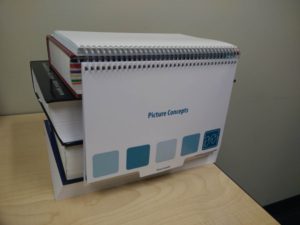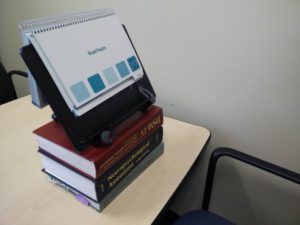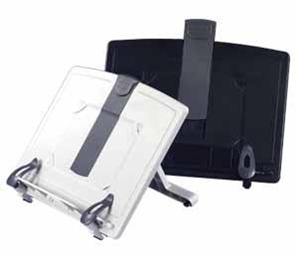Main Body
12 Adaptations for motor and communication impairments
Learning Objectives
- Understand how to optimally adjust the physical testing space.
- Be aware of various alternative response options for children who have difficulty with motor control or communication.
Children with cerebral palsy or other neuromotor conditions present with a wide spectrum of motor involvement. Some children’s motor involvement may be barely noticeable by a novel observer, and will not have any impact on the assessment situation. At the other extreme end, some children will present with almost no voluntary motor control. It is up to the assessor to learn about the individual child’s capabilities, and then set up the testing environment and choose testing materials and adaptations that maximize the child’s ability to demonstrate their knowledge.
Adaptations/modifications and validity of data
All adaptations and modifications to standard testing practices must be carefully documented and considered for their potential impact on test results. Some adaptations are unlikely to have any impact on test results (e.g., allowing the use of a felt pen rather than a pencil for writing, allowing the child to make a response with their voice rather than point on an untimed multiple choice test). When the adaptations or modifications make a change to the demands of the task, it may not be appropriate to interpret the test results using normative data. For example, allowing a child to dictate an essay fundamentally changes the writing demands and makes the task a measure of oral expression rather than written expression. When modifications fundamentally change the way a test is administered, it would most likely be appropriate to interpret the results qualitatively. However, comparison to normative data may also be instructive. For example, for a child who will never be able to write by hand or type due to a motor disability, it would be appropriate to evaluate how the child’s only means of written output (dictation) compares to their peers’ written expression.
Setting up the test materials
For children in a wheelchair, it is important to present materials in a location convenient for the child to see and manipulate. If your table does not change height, you may need another way to present information at the appropriate height. One option is use of a tray that attaches to the child’s wheelchair. This is something the family may be able to bring from home.
Another option is to raise the test materials above the height of the testing table and bring them closer to the child’s eyes. This could involve use of a slant board (also called a “book stand” or “book holder”). This option is especially useful for children who have visual difficulties, or who have difficulty with head or trunk control. Some children may be seated in a harness in their wheelchair to keep them upright which would also keep them from positioning themselves closer to the test material. If you do not have a book stand, you can improvise using books or boxes (e.g., see photos below). You can also raise the height of your slant board by placing it top of books:



Alternate response options for multiple choice tests
For children who have limited or no spoken language, or who have limited or no use of their hands, we need to consider alternate ways the child can make responses during the assessment. In general, the first choice should be to utilize the child’s main mode of communication (gesture, point, words, adaptive equipment). Possible adaptations may include:
- Allow the child to state the number/letter of the response option rather than point. If no number or letter is present, you can create an overlay using clear paper (avoiding glare) or a border cut-out with drawn on numbers. This is typically not appropriate for tasks where speed is important or where it changes the demands of the task. For example, this method of response would be entirely appropriate to use on WISC Matrix Reasoning. On this test, the child has unlimited time to consider the stimulus and possible responses, which are all presented on the same page. However, for a test like WISC Picture Span (where the child is asked to remember a series of picture and point to them in order on the next page), requiring the child to attend to and read the letters associated with each picture increases the cognitive demands of the task. It may be worth attempting, but this adaptation means the results should be interpreted cautiously, as a minimum estimate of capability. Another alternative for Picture Span would be to allow the child to state the names of the objects rather than point. However, this requires that the child is able to name the objects (which is not a requirement of the test), and therefore this also changes the demands of the task.
- If the child is not able to identify numbers or letters (or does not have a way of communicating them to you), you may need to point to each response in turn and ask for a yes/no response. If using this strategy, it is important to keep your facial expression and movements neutral. The best way to do this is to try not to pay attention to what is the correct answer.
- If the child is not able to show consistent use of any communication strategy to respond to the test questions, you may need to consider using a different type of assessment (see non-standardized assessment chapter).
Motor adaptations: Writing
- A pencil can be difficult to use if the child does not exert sufficient pressure (or exerts too much pressure). Regular pens can be difficult because you have to hold them at a specific angle. In this case, a thin felt tip marker can be a good alternative.
- For children with hemiplegia, you may observe that the child does not hold down the paper with their non-dominant hand when writing. If that is the case, you can assist by reminding the child to use their other hand, holding the paper down for them, or taping the paper to the desk.
- To evaluate spelling or written expression, you may choose to allow typing or dictation, especially if that is how the child normally writes. For typing, open a word document, and turn off spell and grammar check. Of course this is a departure from standardized procedures, and thus interpret results with caution. When a child is dictating to you, make sure they can watch you writing in order to get the visual feedback, and have the opportunity to self-correct.
Reading tests with reduced motor or spoken language demands
- Woodcock Johnson – IV (WJ:4)
- Reading Comprehension has a nice way of sampling early reading skills (match word or words to picture, match outline of picture to detailed picture. For children with verbal responses or who can write, this test proceeds to single word responses using fill in the blank (while reading to yourself).
- Sentence Reading Fluency – Answer Yes or No to indicate whether sentences are true or false for 3 minutes (e.g., “A banana is blue” – No). An adaptation for motor impairment would be for the child to state Yes or No aloud (or using gestures) while the examiner marks the response.
- Word Reading Fluency – mark two words that go together in each row in 3 minutes. The same adaptation can be used as for Sentence Reading Fluency.
- Woodcock Johnson also has a braille and large print version available through American Printing House for the Blind.
- Kaufman Test of Educational Achievement – 3 (KTEA-3)
- Silent Reading Fluency: The student silently reads simple sentences and marks yes or no in the Response Booklet to indicate whether the statement is true or false, completing as many items as possible within a two-minute time limit. An adaptation for motor impairment would be for the child to state Yes or No aloud while the examiner marks the response.
- Reading comprehension – early items involve matching a word to a picture then doing an action described in what was read.
- Reading Vocabulary – point to one of 3 words that goes with a given picture. Later read a sentence and point to the word or sentence that has the same meaning. An adaptation could be oral or gestural responses.
- Wechsler Individual Achievement Test -III (WIAT-III) Early Reading Skills subtest has a few items where the person reads the word and points to the matching picture (low level only).
- Bracken Basic Concept Scale – 3 Receptive version asks child to point to colors, letters, letter sounds, numbers, sizes, shapes, etc.
WISC-V and motor/communication adaptations
- Even with limited hand use, many people can do Block Design (though they may have difficulty lining up the blocks and may take extra time). The DAS-II test has an option for an untimed version of block design (Pattern Construction).
- WISC-5 Coding/Symbol Search can be problematic as these tests are heavily dependent on motor speed and vision/visual tracking.
- WISC-5 Arithmetic is a good way look at mental math when a child is not able to work out problems on paper.
- The WISC-5 Integrated has versions of the verbal WISC subtests which are multiple choice. This may have a place in your assessment, but never as a replacement for regular WISC subtests as the task demands are entirely different from the WISC-5 subtests.
Attention & memory and motor/communication adaptations
- The Child and Adolescent Memory Profile (CHAMP) has non-motor response options for the visual memory subtests.
- For verbal memory subtests, if the child is nonverbal or minimally verbal, you can use the multiple choice recognition format to assess comprehension (skipping free recall). As this would be administering the subtest in a non-standardized manner, describe results rather than compare to the normative sample.
Communication
- Receptive language/listening comprehension is an essential skill to assess in children with severe motor and communication disabilities. At a minimum, this would include the ability to hold in mind and follow directions (e.g., NEPSY Comprehension of Instructions if able to use visual/ motor response route or WIAT Listening Comprehension if using auditory/oral response route).
Use of eye gaze for communication in assessments
Children who have limited use of their body, but who have volitional movement of their eyes may use eye gaze for communication. An E-tran (“eye transfer”) board is a low-tech communication system which allows someone to make choices with their eyes. An E-tran consists of a clear acrylic board with a cut-out in the middle. Responses can be Velcro’d or clipped to the corners. The examiner places their face in the middle of the board in order to watch where the person directs their eye gaze. The child would look at the intended response, then look back at the examiner, who speaks the answer aloud. A simple communication system would involve choices between yes/no, with the words YES and NO placed opposite each other. For children who have learned to spell, they may use a system which allows for letter-by-letter selections. It is often helpful to have a second examiner in the room who can note down the child’s responses. Newer, high-tech eye gaze technology uses a camera which tracks a person’s eye gaze across a screen. For many individuals, learning to use eye gaze for communication takes time and lots of practice including training in visual tracking. For some individuals using this type of communication can be very physically demanding and may require multiple short sessions.
Key Takeaways
- It is important to adjust the physical space so that test material is presented at an optimal location for the individual.
- Adaptations should be tailored to the child’s individual motor and communication needs and should be carefully noted in the report.
- It is important to evaluate if adaptations or modifications change the fundamental demands on the task. If they do, it may not be appropriate to use the normative data.
Resources for Further Education

